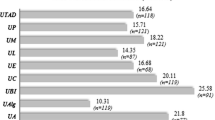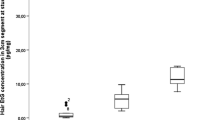Abstract
Hair analysis is a powerful tool for retrospective drug analysis. By determining the minor ethanol metabolites ethyl glucuronide (EtG) and fatty acid ethyl esters (FAEEs) in hair, even a previous consumption of alcohol is detectable. However, previous studies showed a lack of correlation if both parameters are determined simultaneously. A further study was conducted to confirm or refute these results. One hundred and sixty hair samples were analyzed for EtG and FAEE in the context of driving ability. In 109 cases, alcohol abstinence was clearly proven and was excluded in 15 cases. In 36 cases, ambiguous results were found. Possible reasons for the deviating results are discussed. It is recommended, that in context of driving ability diagnostics the EtG result is determinant. In critical cases FAEE concentrations can be determined for checking purposes, but a negative FAEE result cannot refute a determined EtG concentration >7 pg/mg.

Comparative illustration of EtG and FAEE concentrations in 160 hair samples analyzed in the context of driving ability diagnostics. The horizontal lines indicate the cut-off values. Color coding: green → teetotalers, red → social or excessive chronic drinkers, yellow and blue → ambiguous results.





Similar content being viewed by others
References
Pragst F, Auwaerter V, Spokert F, Spiegel K (2001) Analysis of fatty acid ethyl esters in hair as possible markers of chronically elevated alcohol consumption by headspace solid-phase microextraction (HS-SPME) and gas chromatography-mass spectrometry (GC-MS). Forensic Sci Int 121:76–88
Palmer RB (2009) A review of the use of ethyl glucuronide as a marker for ethanol consumption in forensic and clinical medicine. Semin Diagn Pathol 26:18–27
Pragst F, Yegles M (2008) Determination of fatty acid ethyl esters (FAEE) and ethyl glucuronide (EtG) in hair: a promising way for retrospective detection of alcohol abuse during pregnancy? Ther Drug Monit 30:255–263
Politi L, Leone F, Morini L, Polettini A (2007) Bioanalytical procedures for determination of conjugates of fatty acid esters of ethanol as markers of ethanol consumption: a review. Anal Biochem 368:1–16
Janda I, Weinmann W, Kuehnle T, Lahode M, Alt A (2002) Determination of ethyl glucuronide in human hair by SPE and LC-MS/MS. Forensic Sci Int 128:59–65
Morini L, Politi L, Groppi A, Stramesi C, Polettini A (2006) Determination of ethyl glucuronide in hair samples by liquid chromatography/electrospray tandem mass spectrometry. J Mass Spectrom 41:34–42
Lamoureux F, Gaulier J-M, Sauvage F-L, Mercerolle M, Vallejo C, Lachâtre G (2009) Determination of ethyl-glucuronide in hair for heavy drinking detection using liquid chromatography-tandem mass spectrometry following solid-phase extraction. Anal Bioanal Chem 394:1895–1901
Concheiro M, Cruz A, Mon M, de Castro A, Quintela O, Lorenzo A, López-Rivadulla M (2009) Ethyl glucuronide: determination in urine and hair from alcohol withdrawal patients. J Anal Toxicol 33:155–161
Albermann ME, Musshoff M, Madea B (2010) A fully validated high-performance liquid chromatography-tandem mass spectrometry method for the determination of ethyl glucuronide in hair for the proof of strict alcohol abstinence. Anal Bioanal Chem 396:2435–2440
Tarcomnicu I, van Nuijs ALN, Aerts K, De Donker M, Covaci A, Neels H (2010) Ethyl glucuronide determination in meconium and hair by hydrophilic interaction liquid chromatography-tandem mass spectrometry. Forensic Sci Int 196:121–127
Alt A, Janda I, Seidl S, Wurst F (2000) Determination of ethyl glucuronide in hair samples. Alcohol Alcohol 35:313–314
Skopp G, Schmitt G, Pötsch L, Drönner P, Aderjan R, Mattern R (2000) Ethyl glucuronide in human hair. Alcohol Alcohol 35:283–285
Jurado C, Soriano T, Giménez MP, Menédez M (2004) Diagnosis of chronic alcohol consumption. Hair analysis for ethyl-glucuronide. Forensic Sci Int 145:161–166
Yegles M, Labarthe A, Auwärter V, Hartwig S, Vater H, Wennig R, Pragst F (2004) Comparison of ethyl glucuronide and fatty acid ethyl ester concentrations in hair of alcoholics social drinkers and teetotallers. Forensic Sci Int 145:167–173
Paul R, Kingston R, Tsanaclis L, Berry A, Guwy A (2008) Do drug users use less alcohol than non drug users? A comparison of ethyl glucuronide concentrations in hair between the two groups in medico-legal cases. Forensic Sci Int 176:82–86
Kharbouche H, Spokert F, Troxler S, Augsburger M, Mangin P, Staub C (2009) Development and validation of a gas chromatography-negative chemical ionization tandem mass spectrometry method for the determination of ethyl glucuronide in hair and its application to forensic toxicology. J Chromatogr B 877:2337–2343
Álvarez I, Bermejo AM, Tabernero MJ, Fernández P, Cabarcos P, López P (2009) Microwave-assisted extraction: a simpler and faster method for the determination of ethyl glucuronide in hair by gas chromatography-mass spectrometry. Anal Bioanal Chem 393:1345–1350
Agius R, Nadulski T, Kahl H-G, Schräder J, Dufaux B, Yegles M, Pragst F (2010) Validation of a headspace solid-phase microextraction-GC-MS/MS for the determination of ethyl glucuronide in hair according to forensic guidelines. Forensic Sci Int 196:3–9
Zimmermann CM, Jackson G (2010) Gas chromatography tandem mass spectrometry for biomarkers of alcohol abuse in human hair. Ther Drug Monit 32:216–223
Auwärter V, Spokert F, Hartwig S, Pragst F, Vater H, Diefenbacher A (2001) Fatty acid ethyl esters in hair as markers of alcohol consumption. Segmental hair analysis of alcoholics, social drinkers and teetotalers. Clin Chem 47:2114–2123
Wurst FM, Alexson S, Wolfersdorf M, Bechtel G, Forster S, Alling C, Aradóttier S, Jachau K, Huber P, Allen JP, Auwärter V, Pragst F (2004) Concentration of fatty acid ethyl esters in hair of alcoholics: comparison to other biological state markers and self reported-ethanol intake. Alcohol Alcohol 39:33–38
Politi L, Morini L, Leone F, Polettini A (2006) Ethyl glucuronide in hair: is it a reliable marker of chronic high levels of alcohol consumption? Addiction 101:1408–1412
Appenzeller BMR, Agirman R, Neuberg P, Yegles M, Wennig R (2007) Segmental determination of ethyl glucuronide in hair: a pilot study. Forensic Sci Int 173:87–92
De Giovanni N, Donaldio G, Chiarotti M (2007) The reliability of fatty acid ethyl esters (FAEE) as biological markers for the diagnosis of alcohol abuse. J Anal Tox 31:93–97
Wurst FM, Kelso E, Weinmann W, Pragst F, Yegles M, Sundström Poromaa I (2008) Measurement of direct ethanol metabolites suggests higher rate of alcohol use among pregnant woman than found with the AUDIT—a pilot study in a population-based sample of Swedish women. Am J Obstet Gynecol 198:407–411
Bendroth P, Kronstrand R, Helander A, Greby J, Stephanson N, Krantz P (2008) Comparison of ethyl glucuronide in hair with phosphatidylethanol in whole blood as post-mortem markers of alcohol abuse. Forensic Sci Int 176:76–81
Morini L, Politi L, Polettini A (2009) Ethyl glucuronide in hair. A sensitive and specific marker of chronic heavy drinking. Addiction 104:915–920
Morini L, Politi L, Acito S, Groppi A, Polettini A (2009) Comparison of ethyl glucuronide in hair with carbohydrate-deficient transferring in serum as markers of chronic high levels of alcohol consumption. Forensic Sci Int 188:140–143
Høiseth G, Morini L, Polettini A, Christophersen A, Mørland J (2009) Ethyl glucuronide in hair compared with traditional alcohol biomarkers—a pilot study of heavy drinkers referred to an alcohol detoxification unit. Alcohol Clin Exp Res 33:812–816
Süße S, Selavka CM, Mieczkowski T, Pragst F (2010) Fatty acid ethyl esters concentrations in hair and self-reported alcohol consumption in 644 cases from different origin. Forensic Sci Int 196:111–117
Marques P, Tippetts S, Allen J, Javors M, Alling C, Yegles M, Pragst F, Wurst F (2010) Estimating driver risk using alcohol biomarkers, interlock blood alcohol concentration tests and psychometric assessments. Initial descriptives 105:226–239
Pragst F, Rothe M, Moench B, Hastedt M, Herre S, Simmert D (2010) Combined use of fatty acid ethyl esters and ethyl glucuronide in hair for diagnosis of alcohol abuse: interpretation and advantages. Forensic Sci Int 196:101–110
Society of Hair Testing Consensus of the Society of Hair Testing on hair testing for chronic excessive alcohol consumption (2009). Available at: http://www.soht.org/pdf/Consensus_EtG_2009.pdf. Accessed 18 August 2009.
Schubert W, Mattern R (2009) Beurteilungskriterien zur Fahreignungsdiagnostik, 2nd edn. Kirschbaum Verlag, Bonn
Kerekes I, Yegles M, Grimm U, Wennig R (2009) Ethyl glucuronide determination: head hair versus non-head hair. Alcohol Alcohol 44:62–66
Society of Toxicological and Forensic Chemistry (GTFCh) (2009) Anforderungen an die Validierung von Analysenmethoden. T + K 76:185–208.
Foti RS, Fisher MB (2005) Assessment of UDP-glucuronosyltransferase catalyzed formation of ethyl glucuronide in human liver microsomes and recombinant UGTs. Forensic Sci Int 153:109–116
Laposata EA, Lange LG (1986) Presence of nonoxidative ethanol metabolism in human organs commonly damaged by ethanol abuse. Science 231:497–499
Laposata M (1999) Fatty acid ethyl esters: nonoxidative ethanol metabolites with emerging biological and clinical significance. Lipids 34:S281–S285
Hartwig S, Auwärter V, Pragst F (2003) Effect on hair care cosmetics on the concentrations of fatty acid ethyl esters in hair as markers of chronically elevated alcohol consumption. Forensic Sci Int 131:90–97
De Giovanni N, Donadio G, Chiarotti M (2008) Ethanol contamination leads to fatty acid ethyl esters in hair samples. J Anal Tox 32:156–159
Pragst F, Auwärter V, Kießling B, Dyes C (2004) Wipe-test and patch-test for alcohol misuse based on the concentration ratio of fatty acid ethyl esters and squalene C FAEE/C SQ in skin surface lipids. Forensic Sci Int 143:77–86
Tsanaclis L, Kinston R, Wicks J (2009) Testing for alcohol use in hair: is ethyl glucuronide (EtG) stable in hair? Ann Toxicol Anal 21:67–71
Author information
Authors and Affiliations
Corresponding author
Additional information
Published in the special issue Forensic Toxicology with Guest Editors Frank T. Peters, Hans H. Maurer, and Frank Musshoff.
M. E. Albermann and F. Musshoff contributed to this work equally.
Rights and permissions
About this article
Cite this article
Albermann, M.E., Musshoff, F. & Madea, B. Comparison of ethyl glucuronide (EtG) and fatty acid ethyl esters (FAEEs) concentrations in hair for testing abstinence. Anal Bioanal Chem 400, 175–181 (2011). https://doi.org/10.1007/s00216-010-4443-8
Received:
Revised:
Accepted:
Published:
Issue Date:
DOI: https://doi.org/10.1007/s00216-010-4443-8




